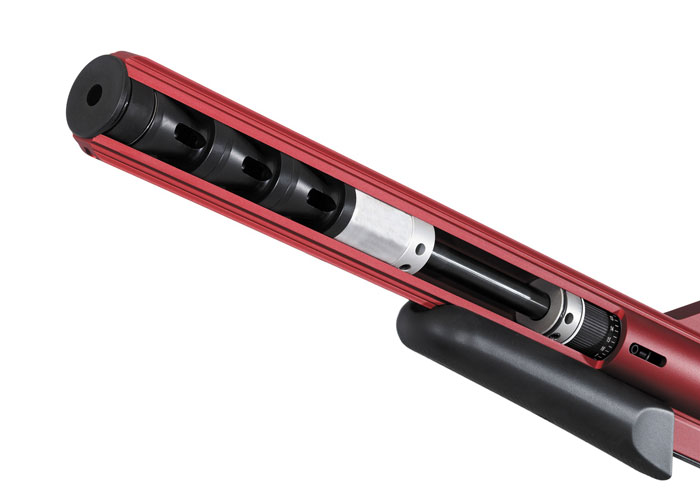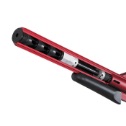Airguns are generally seen as much quieter than firearms. But, as their power has increased with time, so has the shot noise they can produce. As the noise has gone up, the desire to keep airguns as quiet as possible has also gone up.
Manufacturers have taken different approaches to minimize any sound coming out of the airguns they provide customers. Let’s take a look at some of these in this article.
Air Gap
The basic principle of reducing the report of an airgun is to create a barrier between where the air exits the barrel and where it makes it out into the real world. The easiest way to create this air gap is to use a barrel shroud. A barrel shroud is a “tube” that’s of a greater diameter than the barrel. It is also longer than the barrel.
At the end of the barrel, which is called the muzzle, you will generally have an end cap that keeps the barrel centered in the shroud. It also creates a gap between the end of the barrel and the end of the shroud. This gap can be anywhere between 2 to 6 inches, depending on the manufacturer.
The end cap may or may not have holes allowing air to flow back down the shroud, but it’s a good idea if it does so long as the shroud has air exit holes somewhere behind the endcap. This end cap is often called an “air stripper” because it strips the air coming out the muzzle and redirects it away from the front of the gun. Many airgun makers use this method as it’s very inexpensive to develop and works pretty well.
Brands like Kral and Beeman use this method. AirForce airguns also used this in their early models as a basic way to quiet down their PCP airguns.
AirForce has greatly advanced their airgun moderation in the last several years, labeled the Sound-Loc System, primarily using additional baffles in the air gap created by the shroud.

Baffles
As mentioned above, AirForce adopted the use of internal baffles pretty quickly. If you want things to get even quieter, you need to create multiple air chambers within the shroud. Each chamber works with the previous one to strip more and more air away. This reduces the sound that comes out the end of the shroud.
One of the first “mainstream” PCP airguns that incorporated this design was the Benjamin Marauder. At the time, it set the standard for “quiet” airguns and is still held in high regard for that achievement. By adding several cone-shaped baffles, Benjamin reduced the typical loud “pop” down to a muffled “piff.”

Many manufacturers now use barrel shrouds combined with multiple baffles to greatly reduce the report of their guns. It’s a combination that works really well, almost as well as our next option, which is a precision-engineered airgun moderator.
Moderators
The typical thread for a purpose-built airgun moderator, at least in calibers up to .30, is 1/2 UNF. This is different from the standard threaded barrel you’ll find on a firearm. This is a very important distinction as it keeps a buffer between airgun gear and firearm gear. Given that firearm suppressors are highly regulated and possessing one without the proper paperwork is a felony, we need to make sure that these distinctions remain intact.
Manufacturers like FX Airguns and others utilize multiple sound suppression methods on the gun platform themselves. Still, they also include the 1/2 UNF threads at the end of the shroud for shooters to add an after-market airgun moderator of their choosing. These are essentially airgun “suppressors” that are built specifically for airguns and NOT for firearms. When added to the end of an already shrouded airgun, they can reduce the report down to what we call “mouse fart” quiet. It’s really the only way you can get the sound down to the lowest levels possible.
Suppressors
An air gun suppressor (or silencer) is only intended to quiet the report of an airgun since most airguns fire at low velocities and do not break the sound barrier. Whereas firearms break the sound barrier and would require a much more powerful silencing device. Air gun suppressors are not the same as firearm silencers. Air guns are not firearms so they are not regulated by the ATF. An airgun suppressor will also not be regulated by the ATF. But it also will not fit on a firearm. The connection threads on an airgun are different from the connection threads of a firearm.
For big bore air rifles that are unshrouded or use large high-pressure air tanks, like the Texan, an air rifle silencer (or air rifle suppressor) will quiet the report only enough to eliminate the need for hearing protection. It will not fully suppress the report.
Quiet Is In; Loud Is Out
The race for quiet shooting is not just for high-end airguns anymore. It’s become the expected norm on airguns of all price points. While we’ve focused on PCP airguns in this article, the same functions exist in spring or gas ram guns, as well as CO2-powered airguns.
Airgunners want to shoot as quietly as possible, and between a simple shroud, internal baffles, and externally attachable moderators, we can certainly get that done. But remember, it’s good to understand airgun loudness and where all of the noises are coming from since not all noises can be removed with a moderator or adding a suppressor.
If you have questions or want to know more about the options out there, just give us a call here at Airgun Depot and we’ll be very happy to help out!
